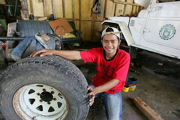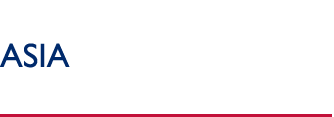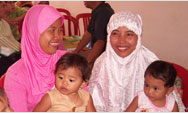 |
|
 |
 |
 |
| USAID Information:
External Links:
|
|
 |
 |
|
 |
 |
|
Philippines

SNAPSHOT
Date of independence: 1946
Capital: Manila
Population: 84.6 million (2006 est)
Annual income per person: $1,420
Source: World Bank Development Indicators 2007
USAID IN PHILIPPINES
philippines.usaid.gov
CONTACTS
Mission Director
Jon D. Lindborg
USAID/Manila
PSC 502, Box 1
FPO AP 96515-1200
Tel: 632-552-9801
Philippines Desk Officer
Deanna Gordon
Tel: (202) 712-0963
Email: degordon@usaid.gov

A young man in the southern Philippines is employed at an automotive repair shop after completing an eight-month job skills training course. USAID is partnering with the Philippine Department of Education and private businesses to help more than 100,000 out-of-school youth in Mindanao return to formal schooling or find gainful employment. (Photo: USAID/Philippines) Overview
A longstanding ally and Southeast Asia’s oldest democracy, the Philippines has historic ties with the United States and is an important development, trading, and regional security partner. Unfortunately, the Philippines has not enjoyed the same level of economic success as its neighbors have over the past 30 years. Nearly 40 percent of the Philippines’ population lives on $2 a day or less. USAID's programs focus on reducing poverty by strengthening peace in conflict-affected Mindanao, promoting good governance, increasing economic opportunities, protecting the environment, strengthening health services, and improving basic education.
Programs
Peace and Security
USAID works with the Philippine government and the private sector to strengthen the foundation for peace and development in conflict-affected areas of Mindanao. Programs give former combatants job skills and expand trade and marketing networks. USAID is also training local officials in alternative dispute resolution mechanisms in more than 1,000 villages. USAID’s anti-trafficking efforts have resulted in high-profile convictions following a nationwide campaign to build the capacity of local prosecutors.
Governing Justly and Democratically
USAID works with the Philippine government to make corruption a high-risk, low-reward activity. Programs target areas where corruption can be most damaging: taxes and customs administration, elections, government procurement, and the judiciary. USAID has helped 15 cities in Mindanao design and carry out good governance and anti-corruption programs. USAID also has helped the anti-graft court move to an automated case management system to speed up the trial process.
Economic Growth
USAID is supporting efforts by the Philippine government and the private sector to improve port efficiency, strengthen the inter-island shipping network, and reduce shipping costs by adopting new technologies. USAID promotes the economic development of Mindanao through infrastructure projects (ports, roads, warehouses, community centers, boat landings, water systems, and trading centers) and by helping over 100 banks and rural cooperatives profitably provide loans and deposit services for small-scale entrepreneurs, including former combatants.
USAID supports efforts to improve accountability and transparency in managing natural resources, enforce environmental laws, and improve solid waste management. USAID programs have provided renewable energy systems to more than 400 remote communities in Mindanao, and USAID supports public awareness campaigns in four major cities to reduce vehicle emissions and improve air quality.
Investing In People: Health
USAID focuses its health sector assistance on prioritizing local government services for the poor and the marginalized in 639 cities and municipalities in 29 provinces nationwide, while ensuring an expanded role for the private sector in responding to the health needs of those who can afford to pay. USAID health programs include maternal and child health, reproductive health, tuberculosis control, food fortification, and surveillance and prevention of HIV/AIDS and emerging diseases like avian influenza. USAID programs have helped local governments increase access to water and sanitation services for more than 200,000 people.
Investing In People: Education
The Philippine education system has higher drop-out rates and poorer test scores than neighboring countries. USAID is increasing access to quality education and livelihood skills in areas most affected by conflict and poverty by training teachers, providing books and computers, constructing and repairing classrooms, and increasing the participation of communities in their children’s education. USAID programs focus on English, science, and mathematics education and on expanding alternative learning and skills training programs for out-of-school youth.
Millennium Challenge Account (MCA)
USAID implements the MCA Philippines Threshold Program on behalf of the U.S. Government’s Millennium Challenge Corporation (MCC). The program focuses on fighting corruption and improving performance in the revenue administration agencies. This enables the Philippines to invest more in health and education to support broad-based economic growth, improve social services, and reduce poverty. The Philippines is now an MCC Compact–eligible country.
Humanitarian Assistance
USAID provides support for natural disaster preparedness and relief by working in partnership with the Philippine government, the Red Cross, nongovernmental organizations, the private sector, and the U.S. military.
Back to Top ^
|


